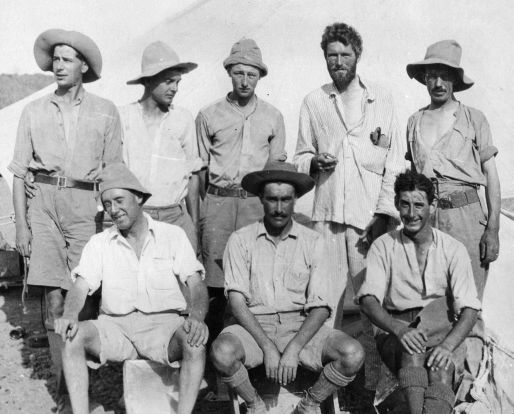LAWRENCE,Captain (later Colonel) Thomas Edward DSO BA (1888-1935). Born 16 August 1888 at Tremadoc in Caernarvonshire. Attended Oxford High School and Jesus College Oxford. As Lieutenant in November 1914, Junior Staff Officer, Intelligence Section, GHQ Cairo. Military Adviser to Emir Feisal.
WILSON,Colonel Cyril Edward CMG DSO, Governor of the Red Sea Province of the Sudan, adviser to Emir Hussein, British Representative to the Arab State. Arranged weapons supplies to the Arab armies.
NEWCOMBE,Lieutenant-Colonel Stewart Francis DSO RE. Railway Engineer, Intelligence Section and Lawrence's boss, who taught him destruction of railways. Later captured by Turks at Beersheba and pow Constantinople.
ROSS,Major Arthur Justin DSO* RE/RFC. First CO of 'C' Flight, Arabian Detachment, 14 Sqn RFC.
STENT,Captain Frederick William MC RFC(SR), (1890-1938). RAeC Certificate No 2748, 31 August 1915 Farnborough; 77 (HD) Sqn RFC, Turnhouse; 17 Sqn RFC Egypt and Salonika; second CO Arabian Detachment and later CO 'X' Flight Akaba; Major CO 111 Sqn RAF (1918), MID twice.
HENDERSON,Captain Thomas MC (1895-1945) RE(TF)/RFC; 2Lt 10 Sqn RFC France 1915; 14 (Reserve) Sqn Catterick Bridge for training as pilot, Certificate 2430, 10 February 1916; 14 Sqn RFC Egypt, 'C' Flight Arabian Detachment; 58 Sqn RAF (1919).
SIDDONS,2Lt Victor Donald (1892-1967); 1/4th Northamptonshire Regt/RFC, pilot, trained at 22 and 23 (Reserve) Sqns, Aboukir, Egypt; CFS Certificate 2728 dated 20 Oct 1916; DFC 1919.
STAFFORD,2Lt William George MC DCM (1879-1928) RE/RFC; Sapper RE No 4 Balloon Section (China); No 22 Sgt Air Battalion RE; pilot CFS Upavon, Cert 438 dated 18 March 1913; Sgt/Major 14 Sqn RFC; 2Lt RFC 1916; Lt/Flying Officer RAF 1918.
|
THE ARAB REVOLT
Upon the outbreak of the Arab Revolt in the Hejaz on 5 June 1916, Emir Hussein sent word to Headquarters British
Military Forces in Cairo, asking for support for the uprising, in the form of, amongst other requests, some aeroplanes and crews to reconnoitre the difficult ground over which he would need to fight. Accordingly, in October 1916, 'C'
Flight of 14 Squadron RFC was assembled at Suez under the command of Captain Albrecht MC. This unit was then identified as the 'Arabian Detachment' of the Hejaz Expedition.
Before we go into details and operations of this unit, it would be politic to make mention of the pronunciation and
particularly the spelling of placenames and persons in the Hejaz. Tribal lore meant that spelling of placenames especially could vary considerably, thus Hejaz, Hijaz, Hedjaz; or Hussein, Hussain, Hussayn etc. A proof-reader at the publishers of T E Lawrence's book Seven Pillars of Wisdom, complained that the author had used different spellings of the same name, such as a favourite riding camel 'Jedha' on one page and 'Jedhah' on another. Lawrence's answer was 'She was a splendid beast'. So it matters not!
Against whom was the Arabian Detachment to operate? The Ottoman (Turkish) armed units in the Hejaz at the time, comprised roughly 21000 men under the overall command of General Liman von Sanders back in Damascus. Identified as part of the IV Turkish Army, there was a large garrison of 14000 in the south of the country, eventually bottled-up in Medina. There were 5000 men at Tebuk and the railway line was usually guarded by second-line troops, about 100 strong every 20 miles or so. The Turkish Army had German advisors and German-trained officers.
It became apparent to Lt-General Sir Archibald Murray, the British Commander in Egypt, that when the Arab Revolt got fully underway, more Turkish troops would be fighting the Arabs than would be fighting him, so British help to the Revolt was considerably increased.
|

